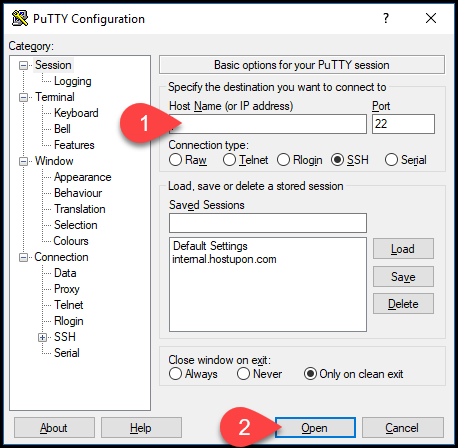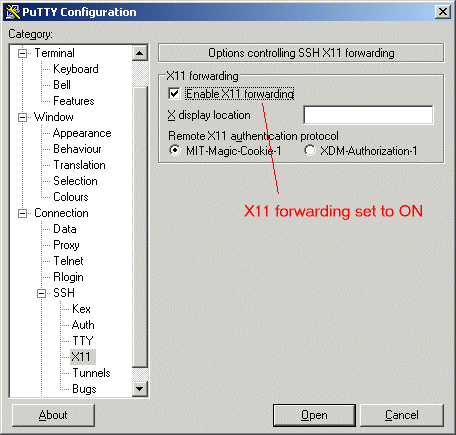

- #Putty ssh to another server how to
- #Putty ssh to another server full
- #Putty ssh to another server windows 8.1
- #Putty ssh to another server code
- #Putty ssh to another server password
If you will use a username and password to connect to your Droplet, skip this step. Make sure 2 is selected for SSH protocol version. Next, click on SSH in the left sidebar (under Connection). Confirm that the Port is set to 22 and that the Connection type SSH is selected. On the PuTTY Configuration screen, fill in the field labeled Host Name (or IP Address) with your Droplet’s IP address, which you can find in the control panel. Add the Droplet IP and Connection Details The following steps guide you through configuring a profile to connect to your Droplet.

Once PuTTY is installed, start the program. If you don’t have PuTTY installed, visit the PuTTY website and choose the Windows installer from the Package files list. It allows you to securely connect to remote servers from a local Windows computer. PuTTY is an open-source SSH and Telnet client for Windows. Each Droplet you create is a new server you can use, either standalone or as part of a larger, cloud-based infrastructure.
#Putty ssh to another server code
Here is the code snippet to make a connection using the WinSCPnet.DigitalOcean Droplets are Linux-based virtual machines (VMs) that run on top of virtualized hardware.
#Putty ssh to another server how to
The owner of the file should also be YourMachineName\usernameĬ# example of how to use the WinSCPnet.dll to make a connection to the OpenSSH server: The permissions for that username should be Read Allow, Write Deny everything else is unchecked. Then delete all Group or user names: except for the Windows login username, e.g: YourMachineName\username To fix the Bad permissions, right click on the administrators_authorized_keys file, goto the Security Tab, click the Advanced button and remove inherited permissions. S-1-5-11 is the name given to the System. Try removing permissions for user: S-1-5-11 on file C:/ProgramData/ssh/administrators_authorized_keys. Then running the one-time command line again, in the logs showed: debug1: trying public key file _PROGRAMDATA_/ssh/administrators_authorized_keysĭebug3: Bad permissions. Had to create the file: C:\ProgramData\ssh\administrators_authorized_keysĪnd copy the public key text into it, e.g: ssh-rsa AAAA.MmpfXUCj rsa-key-20190505Īnd then save the file. The -ddd is verbose level 3.Īfter making a connection, scanning the logs revealed: debug1: trying public key file _PROGRAMDATA_/ssh/administrators_authorized_keysĭebug3: Failed to open file:C:/ProgramData/ssh/administrators_authorized_keys error:2ĭebug1: Could not open authorized keys '_PROGRAMDATA_/ssh/administrators_authorized_keys': This creates a one-time use connection listener.
#Putty ssh to another server full
Note: specify the full path to the exe otherwise sshd complains. Then run:Ĭ:\OpenSSH-Win32>c:\OpenSSH-Win32\sshd.exe -ddd Stop the two OpenSSH services, then open a command prompt with admin permissions. Getting it to work with a public key came down to the permissions on the file:Ĭ:\ProgramData\ssh\administrators_authorized_keys However, authenticating with the username in combination with a private key, the response was server refused our key. It was easy to make a connection using the Windows login username and password.
#Putty ssh to another server windows 8.1
Running Windows 8.1 I ran into the server refused our key problem. I’ve done all this still getting ‘refused our key’ error and I’m out of ideas.

I’ve looked everywhere and all articles and tips mention setting chmod 600 and 700 for the file/directory and formatting the key correctly. Nothing is logged to /var/log/auth.log when attempting to log in with the key. When I try connecting I’m getting 'server refused our key' and server asks for password. Both directory and file owned by the actual user that I try to log in. ssh dir permission level is 700, authorized_keys file permission is 600. So it’s correct (one line, no comments, starts with ssh-rsa, etc.) The public key is this: ssh-rsa AAAAB3NzaC1yc2EAAAABJQAAAQEAopfM6RHOgnuc4Aftn3t4k5UIAT3StCAbn/vg/IMbphbXadshC+79sIlRq3P4zGzMjFTP4hKnzu6ehLV5lmj/qorq3SKT+bPO5Qrac3VbIlrGvuBFDDjP82I2Hwg3HzlsFTstqk++KToapaTYZ7jENEYyPl2wnzITJnt//+4U1o6juoXTKgdNE02hHnRZyHOV/bnkZyJJCEwJv5U0eXSThQnhmXtUxGT8U0HQNFiXfqIIVllhWiCnyrhhIaKz/CIJNAd2VmzyJzQtJtTQX8aWSNVrZju6Sv2/RncTNvsACdNgjjh/FH8PQXaep00jlJ3MOdsC8vz6VSPFbh6iKy1oLQ= rsa-key-20131231 On server (Ubuntu 12.04.3 LTS), I have put my public key in ~/.ssh/authorized_keys. I created key pair using puttygen.exe (client is windows 8).


 0 kommentar(er)
0 kommentar(er)
